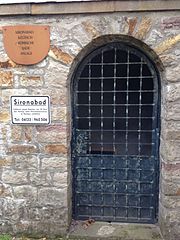Sironabad
The Sironabad is a thermal spring in Nierstein , a town in the Mainz-Bingen district in Rhineland-Palatinate .
history
In 1802, the remains of a Roman spring sanctuary were discovered not far from the banks of the Rhine on the road to Oppenheim, which were assigned to the Buconica military station .
The Belgian merchant Martin van der Velden leased the site, had a total of four springs (two freshwater springs and two mineral-containing springs, one of which had similar ingredients as the recognized medicinal spring located on the southern slope of the Taunus near Weilbach) in a covered, flood-protected drinking facility and sold them the water in Germany, Belgium, Holland and even in Great Britain.
During the clean-up work, a votive altar came to light next to the Roman spring version , which a Roman officer's daughter Julia Frontina had donated to the Celtic spring and healing goddess Sirona and Apollo for a healing .
A stone basin was also found with coins that had been enclosed in plaster for a long time, but showed no signs of use and had apparently been placed in the spring by those who had healed. The coins came from the reigns of the Roman emperors Domitian (86), Nerva (98), Trajan (100 and 112), Hadrian (118 and 119), Antoninus Pius (145), Gordianus III. (239–244), Otacilia Severa , wife of the emperor Philip Arabs (244–249) and of Postumus (267). From this one can conclude that the healing spring was used by the Romans at least from the 2nd to the 3rd century.
literature
- Gerd Rupprecht : Nierstein. MZ. Sirona bathroom. In: Heinz Cüppers (Hrsg.): The Romans in Rhineland-Palatinate. License issue. Nikol, Hamburg 2002, ISBN 3-933203-60-0 , p. 509f.
Web links
- Sironabad on the website of the Nierstein History Association
- Sironabad on regionalgeschichte.net
- Sironabad on nierstein.de
Individual evidence
- ↑ CIL 13, 6272 : Deo / Apollin (i) / et Sironae / Iulia Fron / tina / v (otum) s (olvit) l (ibens) l (aeta) m (erito) .
Coordinates: 49 ° 51 ′ 54 ″ N , 8 ° 21 ′ 8 ″ E

